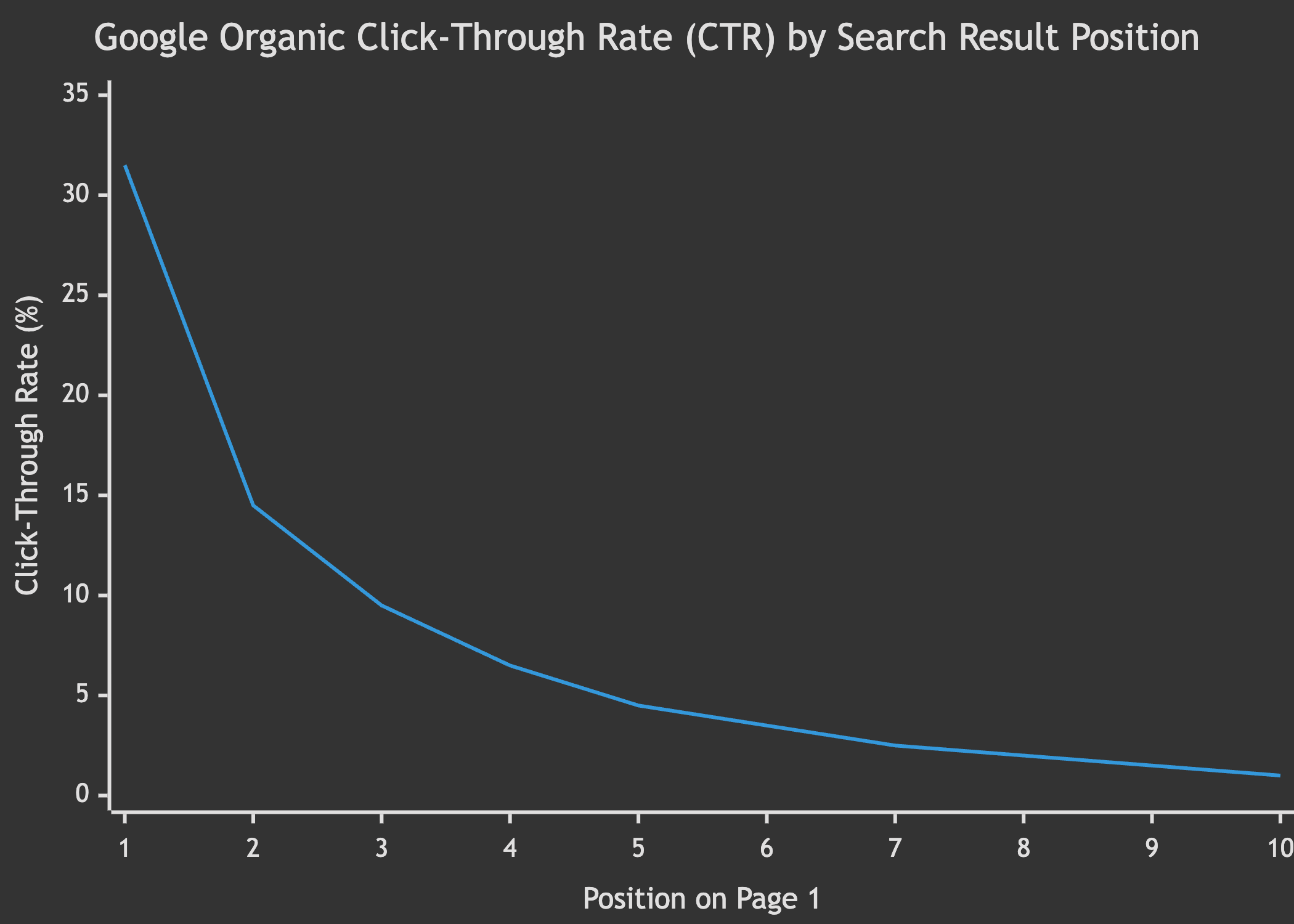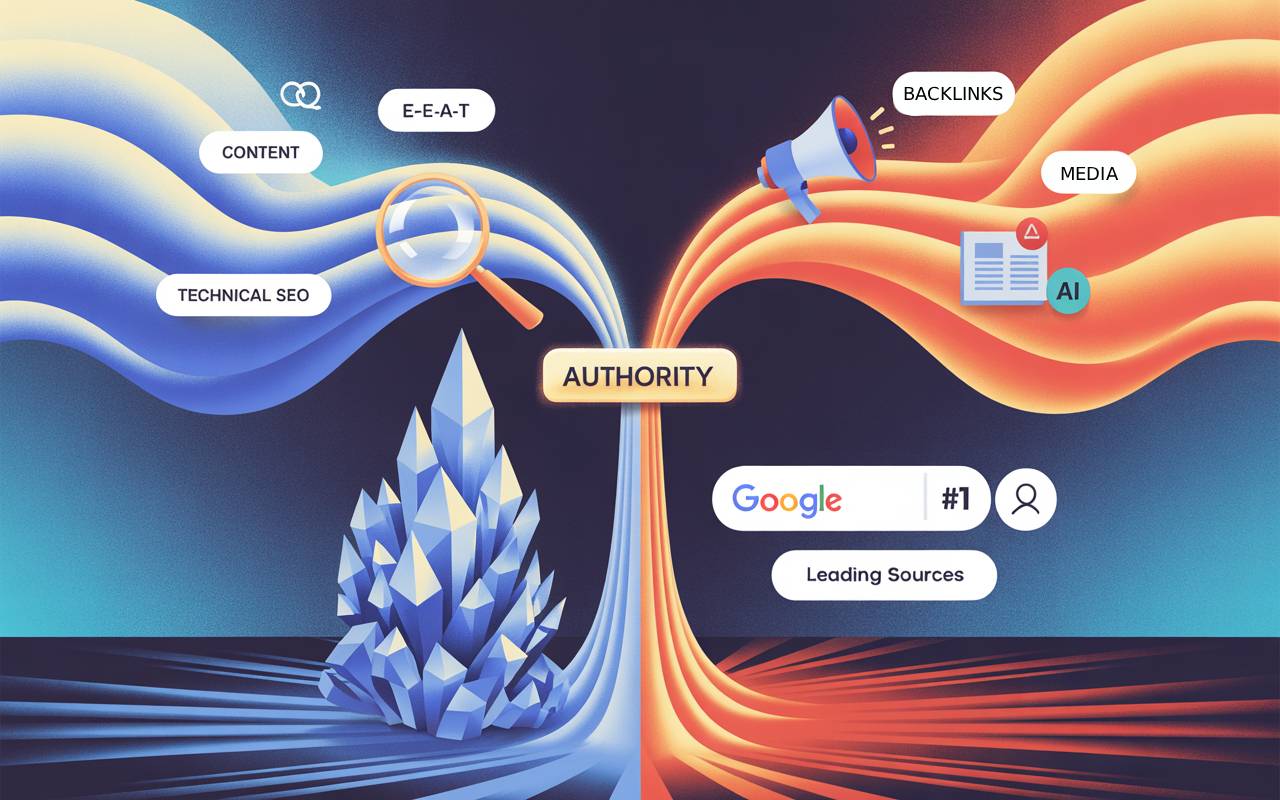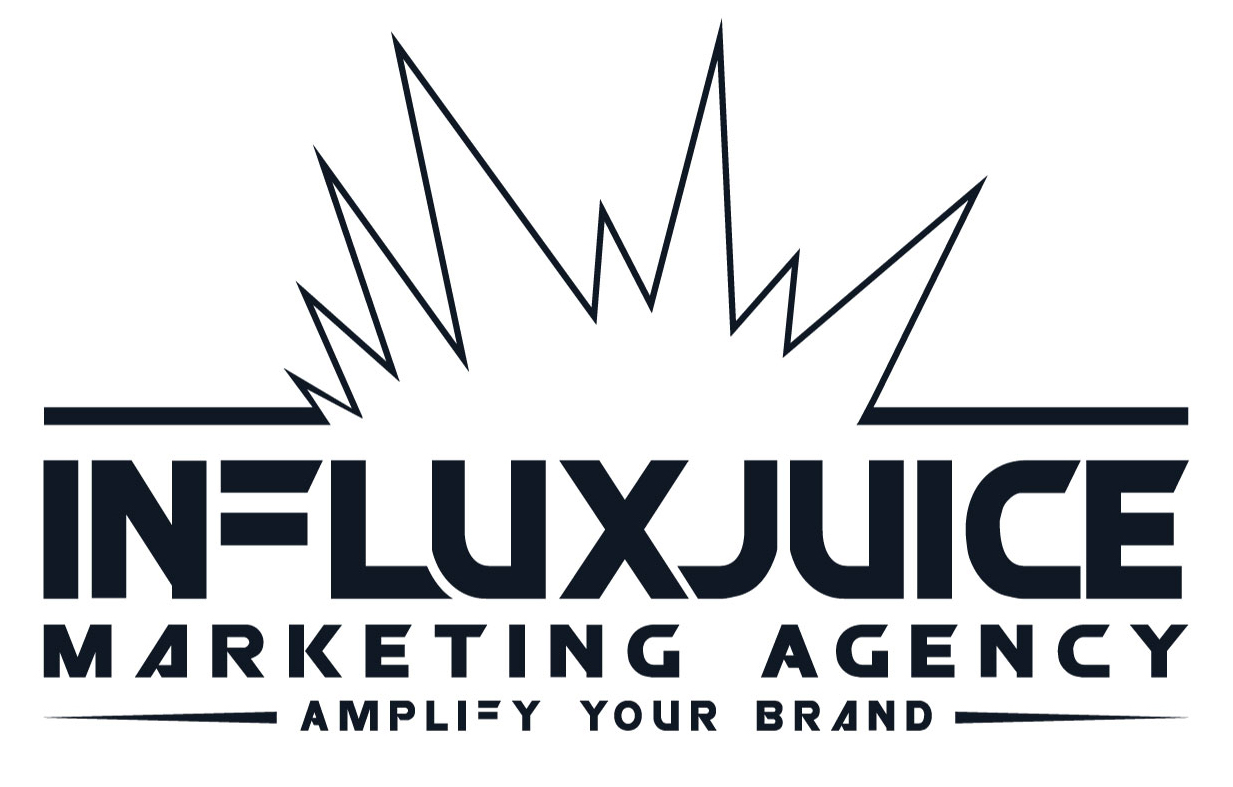Let’s not kid ourselves… digital visibility is a competitive place. For decision-makers in Web3, fintech, and SaaS, where innovation moves rapidly, simply having an online presence is not enough. The critical objective is to be found immediately when your ideal client has a need.
This means securing a prime position where your audience is looking. Historically, this meant the first page of Google. Today, it also means being featured in the concise summaries generated by Large Language Models (LLMs) like ChatGPT, DeepSeek, and Perplexity.
Businesses that fail to appear in these key locations miss their most valuable opportunities. This article explains the data behind this reality and outlines the combined strategy required to win visibility across both traditional and AI-powered platforms.
👀 Quick answers — Jump to section
- The Search Engine Reality
- The New Frontier: Visibility in LLM Responses
- The Consequence of Invisibility
- The InfluxJuice Methodology: SEO/GEO + SEM/GEM
- Conclusion: Visibility is Authority
- FAQ
The Search Engine Reality: The Overwhelming Power of Page One
User behavior on search engines like Google is governed by a simple, unyielding principle: if you’re not on the first page, you effectively do not exist.
The vast majority of users (over 90%) click on a result from the first page of search engines, and a very small minority (typically less than 10%) venture to the second page. This phenomenon is often called “Google’s 90/10 Rule.”
However, the reality is more nuanced. Let’s break down the key statistics and the factors that influence them.
Extensive data on Click-Through Rates (CTR) reveals a dramatic decline in user attention:
- Position #1 captures approximately 27-30% of all clicks.
- Position #2 receives roughly 10-15%.
- Position #3 gets about 7-10%.
- Positions 4-10 see a sharp drop-off from 5% to less than 2%.
- The Second Page (results 11-20) collectively receives less than 1% of all clicks.
This data leads to the common saying in the digital marketing world: “The best place to hide a dead body is on the second page of Google,” highlighting how little traffic those results receive. For growth-focused businesses, this isn’t an option.
Visualizing the Drop-Off
This chart illustrates the dramatic decline in click-through rate from position #1 to position #10:

The New Frontier: Visibility in LLM Responses
The advent of Large Language Models (LLMs) has changed how users seek information. Instead of scrolling through pages of links, users receive a single, consolidated answer.
This move from traditional search engines to generative engines represents a fundamental change in how users interact with information, and therefore, the metrics are very different.
The same “page 1 vs. page 2” statistic doesn’t exist for LLMs, primarily because the concept of a “page” of results is largely obsolete in a chat interface. However, we can analyze analogous user behaviors.
Here’s a breakdown of the key differences and what we know about user interaction with LLM outputs:
1. The Fundamental Difference: Answer vs. Links
- Search Engines (Google): Present a list of links (10 blue links + ads). The user’s job is to scan, evaluate, and click on the most promising one to find their answer. Success is measured in clicks and click-through rate (CTR).
- LLMs (ChatGPT): Present a single, cohesive response (a block of text, code, etc.). The user’s job is to read the provided answer. Success is measured by whether the user gets what they need without having to leave the interface. The primary metric is satisfaction with the single response.
2. The Analogous Behaviors: “Scrolling vs. Probing”
In an LLM interface, user behavior isn’t about moving to a “page 2” of links. Instead, it’s about deepening the conversation thread. The analogous actions to “moving to the second page” are:
- Asking a Follow-up Question: This is the most common action. If the initial answer is incomplete, the user will ask for more detail, examples, or a different angle.
- Requesting Regeneration: Clicking the “regenerate” button forces the LLM to produce a new version of its response to the same prompt. This is like asking the model to “try again.”
- Opening a New Chat: If the initial response is completely off-base, a user might abandon the thread and start a new chat with a rephrased prompt. This is the closest equivalent to “refining your search query.”
3. What the Data Tells Us (So Far)
While comprehensive public stats like the “90/10 rule” for Google don’t yet exist for LLMs, we have strong indicators from user studies and platform disclosures:
- The Vast Majority of Interactions are Single-Turn: A significant portion of users ask a single question and receive their answer. For simple queries (e.g., “Explain quantum computing to a beginner”), the first response is often sufficient, and the chat ends. There is no “second page” to go to.
- High-Value Use Cases are Multi-Turn: The most powerful and “sticky” uses of LLMs involve complex, multi-turn conversations. For example:
- A developer debugging code by pasting an error and then asking follow-up questions.
- A writer brainstorming ideas and then asking the LLM to expand on the best one.
- A user analyzing a document by asking progressively deeper questions.
- “Regeneration” is a Common Action: Early user experience studies suggest that users frequently use the “regenerate” feature, especially for creative tasks (e.g., “write a poem,” “create a tagline”) where they want to see multiple options – similar to how a user might skim multiple results on a search engine results page (SERP).
4. The New “Above the Fold”: The First Response
In LLMs, the entire first response is “above the fold.” The key metric is completeness and accuracy within that first response. If the answer is wrong, incomplete, or poorly structured, the user’s choices are to:
- Give up and leave (a failure).
- Invest effort in a follow-up question to correct it.
- Regenerate the response.
The goal for an LLM is to provide a definitive answer that makes follow-ups optional, not necessary.
Summary: Key Differences at a Glance
| Feature | Traditional Search Engines (Google) | Large Language Models (ChatGPT) |
|---|---|---|
| Output | List of links (10 blue links) | Single, cohesive text response |
| User Action | Click to navigate away | Read and then probe deeper |
| “Page 2” Analog | Clicking “Next” for more links | Asking a follow-up question in the same chat |
| Primary Metric | Click-Through Rate (CTR) | Session Length & User Satisfaction |
| Goal | Referral: Send user to the best site | Retention: Answer the user within the interface |
The paradigm has completely shifted. Instead of worrying about ranking on “page 1,” creators and SEOs now need to worry about whether their content is being used to train the LLM and, more importantly, whether their information is the one being synthesized and presented as the definitive answer within that single, all-important response. This is often referred to as “AI Answer Optimization” or aiming to become the “Source of Truth” for the model.
The High Cost of Digital Invisibility
Failing to secure top visibility has direct consequences for your business.
Lost Authority and Trust: Brands not featured on page one or in AI summaries are unconsciously perceived as less credible. Visibility is a signal of authority.
Missed Revenue Opportunities: The vast majority of potential clients will never discover your solutions. They will click on your competitors or accept the AI’s summary without further research.
Inefficient Marketing Spend: Efforts in content creation, PR, and advertising are significantly less effective if your foundational organic visibility is weak. You are forced to compete on paid channels alone, which is often more expensive.
The InfluxJuice Methodology: Combining On-Site and Off-Site Authority

Achieving and maintaining top visibility requires a dual-pronged approach. At InfluxJuice, we combine two powerful strategies to build undeniable authority for your brand.
1. On-Site SEO/GEO (Search & Generative Engine Optimization)
This foundation ensures your website is perfectly structured for both search engines and AI models. Our process involves:
- Technical SEO Audit: Fixing issues that prevent proper crawling and indexing.
- Content Optimization: Creating comprehensive, expert-level content that directly answers your audience’s questions, making it the best possible result.
- E-E-A-T Signals: Enhancing your content to demonstrate Experience, Expertise, Authoritativeness, and Trustworthiness—a key ranking factor.
- Structured Data: Implementing schema markup to help algorithms understand and feature your content in rich results.
2. Off-Site SEM/GEM (Search & Generative Engine Marketing)
This proactive strategy builds your reputation beyond your own website. We focus on:
- Strategic Link Building: Earning backlinks from high-authority, relevant sites in the Web3 and tech space.
- Digital PR: Securing features, citations, and mentions in industry publications that both Google and LLMs use as authority signals.
- Platform-Specific Engagement: Ensuring your brand is accurately represented and discussed on key platforms like YouTube, Facebook, LinkedIn, Google News, and industry-specific forums.
- AI Knowledge Base Optimization: Proactively ensuring your brand information is accurate across the data ecosystems that feed LLMs.
By combining on-site SEO/GEO with off-site SEM/GEM, we create a powerful feedback loop. Strong on-site content attracts off-site signals, and those off-site signals boost your on-site authority, leading to higher rankings and more frequent inclusion in AI summaries.
Key Takeaway: Visibility Is Authority
Your business’ visibility is directly proportional to your perceived authority. For Web3 founders and B2B decision-makers, appearing on the first page of Google and within the summaries of LLMs is not merely a marketing tactic, it’s a core business requirement.
It is the process of establishing your brand as the definitive answer to your audience’s most pressing questions, wherever they are asked.
FAQ
Q: How long does it take to see results from this combined approach?
A: SEO and authority building are medium to long-term strategies. Initial technical improvements can yield quick wins, but sustained growth in rankings and AI visibility typically takes 4-6 months of consistent effort to show significant, compounding results.
Q: Is traditional SEO now dead because of AI and LLMs?
A: Absolutely not. The fundamentals of SEO (technical health, quality content, and E-E-A-T) are more important than ever. LLMs use similar signals to determine authority. A strong SEO foundation is the prerequisite for visibility in AI tools.
Q: My business is highly technical and niche. Can we really rank?
A: Yes. In fact, niche B2B and Web3 businesses often have a significant advantage. The competition for highly specific terms is lower, and demonstrating expertise is easier. Our strategy focuses on dominating your specific niche before expanding.
Q: How do you measure success with LLM visibility?
A: We track several key metrics: a increase in “brand mentions” in industry reports (a key LLM source), a rise in traffic from AI-powered platforms, and monitoring for direct citations of our clients’ content as a source in AI responses themselves.
Q: What’s the first step to getting started?
A: The first step is a comprehensive authority audit. We analyze your current on-site SEO health and your off-site digital footprint to identify the biggest opportunities to quickly increase your visibility and authority across all platforms.
✍️ Question: What’s the single biggest challenge your brand faces in being discovered by new clients online?
Share your thoughts in the comments below.
_________________________________________________________________
Get your business referenced on ChatGPT with our free 3-Step Marketing Playbook.
Want to know how we can guarantee a mighty boost to your traffic, rank, reputation and authority in you niche?
Tap here to chat to me and I’ll show you how we make it happen.
If you’ve enjoyed reading today’s blog, please share our blog link below.
Do you have a blog on business and marketing that you’d like to share on influxjuice.com/blog? Contact me at rob@influxjuice.com.

